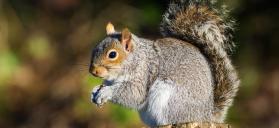 |
| Fact Sheet |
| Scientific Name |
Sciurus carolinensis |
| Description |
Often seen in backyards, parks and wooded rural areas. Because of its thick furry tail, it is sometimes called bushytail. Gray squirrels may have white or brownish bellies and, in winter, white ear tufts. Black and albino squirrels are variations of the gray squirrel. |
| Total Length |
8 to 10 inches, with a tail roughly the same length |
| Weight |
1.5 pounds |
| Color |
Mostly gray with a white to rusty-colored underside and rust-colored ears |
| Reproduction |
Gray squirrels mate twice a year, typically from December to February and /or June through August. They nest in tree hollows or in a tree-top den, which is a 12- to 19-inch ball-shaped nest made of leaves, twigs and bark. Mother squirrels have 2 to 4 babies, which are born hairless and weigh 1/2 ounce. By the time they are 12 weeks old, young squirrels are completely independent. |
| Food |
Acorns, hazelnuts, walnuts, and seeds of many trees, plus fungi, and elm buds in late winter--all are important foods for squirrels. Squirrels are accused of digging up lawns as they bury acorns. They may also dig up flower bulbs and, in years past, were serious pests around small cornfields and wooden corn cribs. |
| Predators |
Cats, hawks, coyotes, foxes, weasels, bobcats. Some people hunt and eat gray squirrels. |
| Habitat and Range |
Gray squirrels live in hardwood forests, wooded parks and residential areas. They make their homes in tree cavities but also build leafy nests in summer and fall. By chewing on the scars where small dead branches have fallen, squirrels help to make nesting cavities for future generations. |


